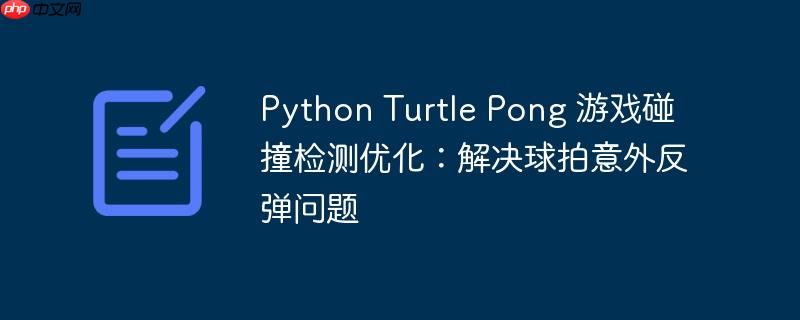
在开发基于 python turtle 库的 pong 游戏时,精确的碰撞检测是确保游戏逻辑正确性的关键。一个常见的错误是球体在未接触到球拍时,却意外地从墙壁反弹。这通常是由于碰撞检测逻辑中的布尔判断不当造成的。本教程将详细解析这一问题,并提供一套优化的解决方案。
问题的核心在于球拍碰撞检测的条件判断语句:
if the_ball.distance(r_paddle) and the_ball.xcor() > 320 or the_ball.distance(l_paddle) < 50 and the_ball.xcor() < -320:
the_ball.x_bounce()乍一看,这个条件似乎合理,它尝试判断球与右球拍的距离以及球的 x 坐标,或者球与左球拍的距离以及球的 x 坐标。然而,the_ball.distance(r_paddle) 方法返回的是一个浮点数,表示两个 Turtle 对象之间的距离。在 Python 中,任何非零的数字在布尔上下文中都会被评估为 True。这意味着只要球与右球拍之间存在任何距离(即不完全重叠),the_ball.distance(r_paddle) 就会被视为 True。
因此,the_ball.distance(r_paddle) and the_ball.xcor() > 320 这一部分,只要球的 x 坐标大于 320(表示球靠近右侧边界),并且球与右球拍有任何距离,条件就可能为真。这导致球在达到右侧边界时,即使没有碰到球拍,也会被误判为与球拍碰撞并反弹,从而使得整个右侧区域都表现得像一个巨大的球拍。
正确的做法是,我们需要将 distance() 的返回值与一个预设的阈值进行比较,以确定球是否足够接近球拍,从而触发碰撞。
立即学习“Python免费学习笔记(深入)”;
要解决上述问题,我们需要明确指定碰撞的距离阈值。通常,这个阈值应小于球拍的宽度或高度的一半,以模拟真实的碰撞。对于 distance() 方法,我们应该将其与一个具体的数值进行比较,例如 50,这通常是球拍高度的一半(因为球拍 shapesize(5, 1) 意味着高度是 5 * 20 = 100 像素,所以 50 像素是一个合理的碰撞半径)。
修正后的碰撞检测逻辑应为:
# 碰撞检测条件修正
if the_ball.distance(r_paddle) < 50 and the_ball.xcor() > 320 or \
the_ball.distance(l_paddle) < 50 and the_ball.xcor() < -320:
the_ball.x_bounce()通过添加 < 50,我们现在明确要求球与球拍的距离小于 50 像素才算作碰撞。这确保了只有当球真正接近球拍时,才会触发反弹。
除了核心的碰撞判断错误,游戏循环的结构和动画更新方式也可以进行优化,以提供更流畅的体验和更清晰的逻辑。
游戏循环的改进:screen.ontimer() 使用 time.sleep() 会阻塞程序的执行,导致动画不够流畅。更推荐的方法是使用 screen.ontimer() 来安排函数的重复执行。这是一种非阻塞的方式,允许 Turtle 屏幕在两次调用之间继续处理事件和更新。
def play():
the_ball.move()
# 碰撞检测和得分逻辑
# ...
screen.ontimer(play, 100) # 每 100 毫秒调用一次 play 函数逻辑顺序的重要性:if-elif 结构 在游戏循环中,事件处理的顺序至关重要。球可能同时满足多个条件(例如,碰到墙壁的同时也可能靠近球拍)。使用 if-elif 结构可以确保条件按优先级顺序进行评估,避免逻辑冲突。
def play():
the_ball.move()
# 1. 碰撞上下墙壁
if not -280 < the_ball.ycor() < 280:
the_ball.y_bounce()
# 2. 碰撞球拍 (使用 elif 确保优先级)
elif the_ball.distance(r_paddle) < 50 and the_ball.xcor() > 320 or \
the_ball.distance(l_paddle) < 50 and the_ball.xcor() < -320:
the_ball.x_bounce()
# 3. 球出右界 (左边得分)
elif the_ball.xcor() > 380:
the_ball.reset_position()
score.left_point()
# 4. 球出左界 (右边得分)
elif the_ball.xcor() < -380:
the_ball.reset_position()
score.right_point()
screen.ontimer(play, 100)实时更新屏幕:screen.update() 当 screen.tracer(0) 被调用以关闭自动屏幕更新时,需要手动调用 screen.update() 来刷新屏幕显示。在每次球移动、分数更新或球拍移动后调用 screen.update(),可以确保动画的流畅性。
以下是整合了所有修正和优化的 Pong 游戏代码:
from turtle import Screen, Turtle
# 屏幕实例,全局可访问,方便在类中调用 update
screen = Screen()
class Scoreboard(Turtle):
def __init__(self):
super().__init__()
self.hideturtle()
self.color('white')
self.penup()
self.l_score = 0
self.r_score = 0
self.update_score()
def update_score(self):
self.clear()
self.goto(-100, 200)
self.write(self.l_score, align='center', font=('Courier', 80, 'normal'))
self.goto(100, 200)
self.write(self.r_score, align='center', font=('Courier', 80, 'normal'))
screen.update() # 每次分数更新时刷新屏幕
def left_point(self):
self.l_score += 1
self.update_score()
def right_point(self):
self.r_score += 1
self.update_score()
class Ball(Turtle):
def __init__(self):
super().__init__()
self.shape('circle')
self.color('white')
self.penup() # 确保不画线
self.x_move = 10
self.y_move = 10
def move(self):
new_x = self.xcor() + self.x_move
new_y = self.ycor() + self.y_move
self.goto(new_x, new_y)
screen.update() # 每次球移动时刷新屏幕
def y_bounce(self):
self.y_move *= -1
def x_bounce(self):
self.x_move *= -1
def reset_position(self):
self.goto(0, 0)
self.x_bounce() # 重置后球反向移动
screen.update() # 重置位置后刷新屏幕
class Paddle(Turtle):
def __init__(self):
super().__init__()
self.shape('square')
self.color('white')
self.shapesize(stretch_wid=5, stretch_len=1) # 默认朝向右,这里设置宽5高1
self.penup()
# 可以设置朝向,然后使用 forward/backward
# self.setheading(90) # 让其朝上,这样 forward/backward 就是上下移动
def go_up(self):
new_y = self.ycor() + 20
self.goto(self.xcor(), new_y)
screen.update() # 每次球拍移动时刷新屏幕
def go_down(self):
new_y = self.ycor() - 20
self.goto(self.xcor(), new_y)
screen.update() # 每次球拍移动时刷新屏幕
# 游戏初始化
screen.setup(width=800, height=600)
screen.bgcolor('black')
screen.title("My PONGIE")
screen.tracer(0) # 关闭自动屏幕更新
r_paddle = Paddle()
r_paddle.goto(350, 0) # 右球拍
l_paddle = Paddle()
l_paddle.goto(-350, 0) # 左球拍
the_ball = Ball()
score = Scoreboard()
# 键盘监听
screen.listen()
screen.onkey(r_paddle.go_up, 'Up')
screen.onkey(r_paddle.go_down, 'Down')
screen.onkey(l_paddle.go_up, 'w')
screen.onkey(l_paddle.go_down, 's')
# 游戏主循环函数
def play():
the_ball.move()
# 1. 碰撞上下墙壁检测
if the_ball.ycor() > 280 or the_ball.ycor() < -280:
the_ball.y_bounce()
# 2. 碰撞球拍检测 (注意逻辑顺序和距离判断)
elif (the_ball.distance(r_paddle) < 50 and the_ball.xcor() > 320) or \
(the_ball.distance(l_paddle) < 50 and the_ball.xcor() < -320):
the_ball.x_bounce()
# 3. 球出右界 (左边得分)
elif the_ball.xcor() > 380:
the_ball.reset_position()
score.left_point()
# 4. 球出左界 (右边得分)
elif the_ball.xcor() < -380:
the_ball.reset_position()
score.right_point()
screen.ontimer(play, 10) # 每 10 毫秒调用一次 play,实现更流畅动画
# 初始屏幕更新,显示所有对象
screen.update()
# 启动游戏循环
play()
# 保持窗口打开直到关闭
screen.mainloop()通过本教程,我们深入分析了 Python Turtle Pong 游戏中一个常见的碰撞检测错误,即 distance() 方法的布尔误用。我们不仅提供了精确的修复方案,即通过与距离阈值进行比较来正确判断碰撞,还优化了游戏的整体逻辑结构和动画刷新机制。这些改进不仅解决了特定的 bug,也提升了游戏的整体性能和用户体验,为未来的游戏开发奠定了坚实的基础。
以上就是Python Turtle Pong 游戏碰撞检测优化:解决球拍意外反弹问题的详细内容,更多请关注php中文网其它相关文章!

每个人都需要一台速度更快、更稳定的 PC。随着时间的推移,垃圾文件、旧注册表数据和不必要的后台进程会占用资源并降低性能。幸运的是,许多工具可以让 Windows 保持平稳运行。

Copyright 2014-2025 https://www.php.cn/ All Rights Reserved | php.cn | 湘ICP备2023035733号